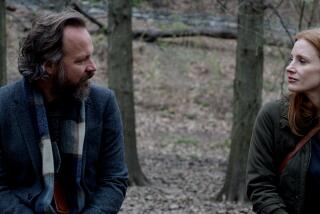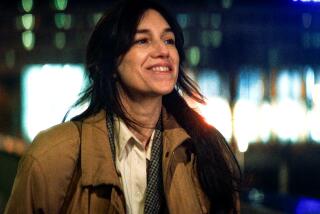A Daring ‘Bridge’ Over Pair of Troubled Souls in 1989 Paris
- Share via
Leos Carax’s “The Lovers on the Bridge” has the raw, gritty look of a documentary on the homeless, but it is in the grand tradition of heady screen romances. It’s a throwback to the golden era of both Hollywood and of the fatalistic French cinema that teamed such international icons as Jean Gabin and Michelle Morgan. Yet this 1991 film, rescued by Martin Scorsese and Miramax Zoe--a specialty arm of Miramax--is a go-for-broke dazzler that takes constant chances, dares to go over the top, indulges in one anticlimactic scene after another only to make such risks pay off all the more at the finish.
The film opens as a bedraggled young woman (Juliette Binoche), a patch over her left eye, gazes on a young man (Denis Lavant) who’s passed out at night on a Paris street and is about to be struck by a bus. Once sobered up in a government clinic where his broken ankle is placed in a cast, Lavant’s Alex, a fire-eating street performer, returns to his makeshift shelter in one of the alcoves of Paris’ oldest bridge, the elegant but crumbling Pont-Neuf, which has been closed for repairs. (Ultimately denied permission to film on the actual Pont-Neuf, Carax and his dauntless art director Michel Vandestein magically re-created it and its environs on a Montpeilier lake.)
The next time the two cross paths, Binoche’s Michele has made her way to the bridge, also seeking shelter. Initially, Alex’s pal, the gruff, aging Hans (Klaus-Michael Gruber), a wino with a supply of some drug that allows Alex to sleep, resists Michele’s presence, believing that survival on the most primitive level is endangered by any emotional involvement. Not long thereafter Alex, a knobby, scarred ragamuffin of a man with a doughy nose, starts falling in love with Michele, an artist--Binoche painted Michele’s lovely watercolors herself. We gradually learn she is losing her sight and also has been devastated by the rejection of her lover.
While Alex and, especially, Michele are hesitant about consummating their love physically, they are swept up in their passion for each other. Amid filth and deprivation, their spirits start to soar, as explosively as the fantastic fireworks displays along the Seine marking the 1989 bicentennial of the French Revolution. From this sequence, which culminates in Alex commandeering a police patrol boat from which Michele can water ski, Carax comes up with many tempestuous incidents delineating the grandeur of their passion and the uncertainty of their future.
All these twists and turns--some of them pretty outrageous on the face of it--work shamelessly to catch us up in the lovers’ fate, which becomes a matter of surprisingly urgent suspense. You may also be surprised at how deeply you can respond to such emotional extravagance.
Bravura barely begins to describe Carax’s kinetic style, his skills as a storyteller or his ability to wring the most out of his actors. (Michele is a far more demanding role than that of the nurse in “The English Patient” that won Binoche an Oscar.) The highly diverse music selections, made by Carax himself, provide sweeping permutations that help define, shape and sustain the film, echoing the limitlessly mobile and bold cinematography of Jean Yves-Escoffier.
As “The Lovers on the Bridge” progresses, the Pont-Neuf becomes a symbol of transition; if ever Michele and Alex are to have a life together they will have to learn to cross it and move on.
* MPAA rating: R, for violence, language, sexuality/nudity and substance abuse. Times guidelines: some language, sex and violence, and adult themes and situations.
‘The Lovers on the Bridge’
(‘Les Amants du Pont-Neuf’)
Denis Lavant: Alex
Juliette Binoche: Michele
Klaus-Michael Gruber: Hans
Daniel Buain: Alex’s vagrant friend
A Miramax Zoe and Martin Scorsese presentation of Christian Fechner production. Writer-director Leos Carax. Executive producers Herve Truffaut and Albert Prevost. Cinematographer Jean-Yves Escoffier. Editor Nelly Quettier. Art director Michel Vandestein. Set decorator Jacques Dubus. In French, with English subtitles. Running time: 2 hours, 11 minutes.
At selected theaters.
More to Read
Only good movies
Get the Indie Focus newsletter, Mark Olsen's weekly guide to the world of cinema.
You may occasionally receive promotional content from the Los Angeles Times.







